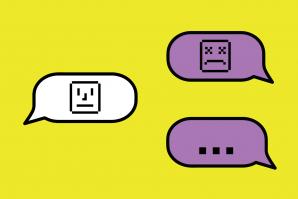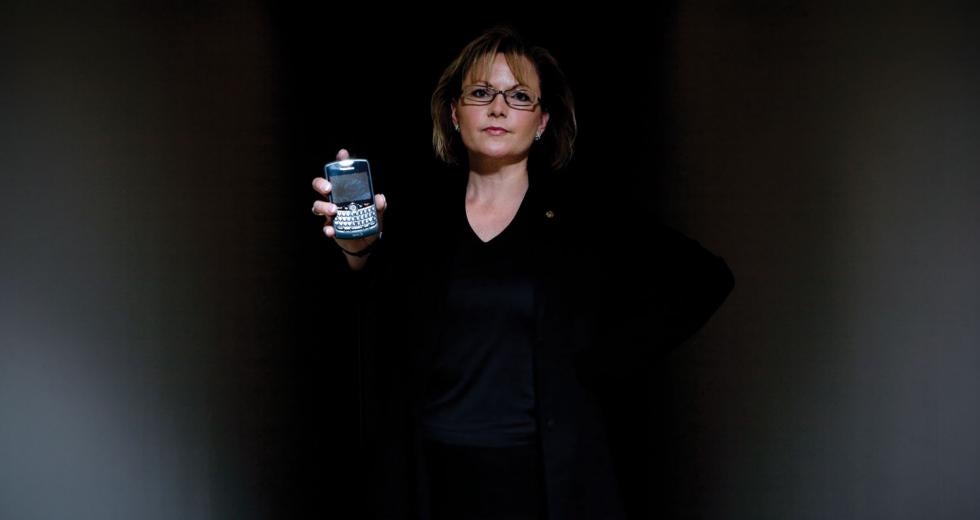Late on a work night, Amy Mathews picked up her ringing BlackBerry to find a frantic customer on the other end. On an airplane nearing departure for Buenos Aires, a woman realized her debit card was on the verge of expiration. She would be out of the country for weeks without an easy way to access cash. Mathews knew she held the solution in her palm. From her BlackBerry, the corporate banking manager at Mechanics Bank fired off a couple emails and got a new debit card ordered in minutes.
“That kind of instant connection with me or somebody here at my office is what puts her mind at rest, what makes her trip OK,” Mathews says. “I think the expectation from our customers now is that we’re available [via mobile technology]. Because they are, they expect the same from us.”
Mobile phone technology continues to remake vast stretches of the
corporate landscape. In the hunt for cost efficiencies, companies
are driving the growth of smart-phone and PDA sales in the face
of a steep recession. Some one in three U.S. workers now use a
smart phone, according to industry figures.
“By 2013, nearly half the mobile phones bought in the U.S. will be smart phones.”
IDC, a global research firm
Transportation and shipping companies pioneered the adoption of mobile technology. But in recent years, industries such as banking and health care have embraced smart phones and their ilk as avenues to increase productivity, buoy customer service and strengthen internal communication.
“We’re communicating at a whole different level,” says Mathews, who’s worked at the â?¨Roseville bank for almost a decade. “The response time is not only constant and fluid, but it’s so quick you can get a problem solved in two emails.”
The shift to a massively mobile work force comes with caveats and caution about privacy, information safety and the evaporating line between work and home life. But for both companies and consumers, the mobile evolution is ushering in a new era of communication and customer interaction.
“I don’t think you’ll ever get to the point where it’s 100 percent smart phones, but you’ll [certainly find] there is going to be greater adoption and greater use of wireless and mobile technology,” says Philippe Winthrop, a Boston-based analyst and research director of business mobility solutions for Strategy Analytics. “You’re going to find more and more things being untethered.”
Smart phones appear nearly recession-resistant after a stellar start in 2009.
Sales were up almost 13 percent in the first quarter compared to 2008. Apple’s iPhone 3G doubled its market share, and the company shipped 3.9 million units in the first quarter, according to Gartner Inc., a global information technology research and advisory company.
According to Gartner, those were among the sole bright spots in an otherwise grim stretch for global cell phone sales, which fell about 9.4 percent in the first quarter compared to last year.
In part, the recession is driving the surge in smart phone sales. Businesses desperate to trim costs are spending more money investing in mobility, Winthrop says.
“Top of mind to any organization right now is cost control,” he says. “There’s always been talk in the industry from vendors about how mobility solutions can reduce (operational expenses). Now, organizations are looking to them even more.”
More than 90 percent of businesses now have at least one smart phone. The actual penetration rate is around 30 percent, up from about 22 percent in 2008, Winthrop says.
The response time is not only constant and fluid, but it’s so quick you can get a problem solved in two emails.”
Amy Mathews, corporate banking manager, Mechanics Bank
By 2013, nearly half the mobile phones bought in the U.S. will be smart phones, according to IDC, a global research firm based in Massachusetts.
An array of business-centric mobile software from manufacturers such as Verizon and Apple has made it easier for companies to store documents, automate processes and capture information. Mobile productivity software is allowing some businesses to eliminate the trappings and redundancies of traditional office life, from spreadsheets and fax machines to notepads and calendars.
Smart phones are also giving workers more flexibility in terms of where and when they work.
Many mornings, Mathews walks into her office at Mechanics Bank with a nearly clean slate after responding to BlackBerry messages from home.
“The clock doesn’t start ticking for me at 8:30 in the morning,” she says. “It actually makes me come in and start my day more efficiently.”
Mathews and her colleagues at Mechanics are betting that desire for efficiency and access will resonate with their customers. This month, the bank is rolling out a new mobile banking service that will allow customers to transfer money, view transactions, track purchases and pay bills online all through their smart phones and PDAs.
The new system provides a competitive advantage for a smaller outfit such as Mechanics, a business rooted in customer service.
Given the growing adoption of smart-phone technology, mobile banking is emerging nationally as a mainstream no-brainer for banks of various sizes. Earlier this year, Bank of America announced it had almost 2 million mobile banking customers, an increase of 1 million in nine months, according to TowerGroup, a global financial services research firm based in Massachusetts.
The organization estimates mobile banking users to grow from 10 million users in 2009 to more than 53 million in 2013.
At Mechanics, the new mobile banking system will also likely curb some of the inquiries Mathews and her â?¨co-workers receive from customers regarding their balances or recent transactions.
You were chained to your desk because of the phone. Now, with the instant communication, things seem calmer.”
Ray Plyler, vice president of information technology, Freight Solutions Providers
But she expects that this emerging mobile technology will simply blend with the personal interaction customers have come to depend on through email and telephone calls.
In other words, those late-night emails from customers poring over their books will continue to come in, as will those frantic, last-minute phone calls.
“I have a feeling they’ll be calling us a whole lot less,” Mathews says. “I think each individual will drive how far they take it.”
But banking isn’t the only industry to embrace mobile technology; transportation companies have been using these systems for years. Take, for example, Ray Plyler, who works in an industry built on ever-changing information. Freight Solutions Providers offers transportation logistics for large, high-end shipments throughout North America.
Prices, drivers, routes and customer needs all change on the fly. Just a handful of years ago, that meant FSP workers didn’t stray from their cubicles.
“You were chained to your desk because of the phone,” says Plyler, vice president of information technology for the Rancho Cordova company. “Now, with the instant communication, things seem calmer.”
Smart phones have become the standard at FSP, from the chief executive officer and president on down. Company policy calls for all communication that can be in email form to be in email form.
The mobile evolution has proved a tremendous boost for internal communication at FSP. With freight shipments coursing through Canada, Mexico and the U.S., FSP employees rely on BlackBerrys — and a couple of iPhones — to stay abreast of changes with carrier trucks, field agents and other transportation partners.
“Anytime you have 1,000 parts moving, you have to be on top of them,” says Plyler, who uses a BlackBerry. “It’s all about instant communication, and it relates ultimately to providing a better customer service. Internally, it just means that we can respond to whatever change hits us and get key people involved as necessary.”
Smart phones are even altering the way health care is delivered in the U.S. Almost two-thirds of American physicians are using smart phones, according to a recent study by Manhattan Research, a pharmaceutical and health care market research firm.
The number of doctors using iPhones has doubled in the past year alone, according to the study.
Mobile devices are rapidly replacing pagers in hospital settings. Beyond that, smart phones and PDAs allow patients to snap a picture of a suspicious rash and email it directly to a physician’s smart phone for an instant diagnosis.
Apple already offers more than 150 medical applications for the iPhone.
About one in four workers takes his or her laptop and smart phone to bed.
Credant Technologies
Despite the promising potential, there are concerns that smart phones and PDAs are having a negative impact on workers’ health and well-being. Constant connectivity can come at a price — namely, the erosion of personal time.
But many business and tech-savvy experts say striking a healthy work-life balance is still possible in the age of the iPhone.
About one in four workers takes his or her laptop and smart phone to bed, according to an April survey by Credant Technologies. More than 55 percent of respondents worked there between two and six hours a week.
Beyond the bedroom, scores of business leaders and even lower-level workers complain of answering emails or phone calls after hours or during vacations.
Mathews says the convenience of connectivity balances out the intrusion on personal time. Those late-night calls can also make the difference for customers.
For example, Mathews fielded a call at home one evening from a client who had spotted a $20,000 discrepancy with his account. Mathews talked the client through the figures until they realized it was a mistake on his end.
Relieved, he told Mathews he would never bank anywhere else.
“If you can win a customer for life, it’s a small price to pay,” she says. “To me, it’s just more liberating because it’s there when I want it to be there. Like anything else, you have to manage it.”
Plyler remembers recent emails on his BlackBerry while fishing an Oregon river. While a 3 a.m. phone call or email on vacation isn’t ideal, Plyler would much rather deal with a problem in real time rather than wait until his return to the office.
“It seems like it’s horribly invasive, but it’s actually the opposite,” he says. “I’m responsible for this — I want to know. If I don’t, then I’m under stress.”
There’s also the problem of security and safety.
Smart phones and PDAs are prone to the same viral meltdowns that strike personal computers. At the same time, businesses such as banks and medical offices work to ensure that a consumer’s personal information is safeguarded and properly protected.
Companies also provide their workers with sensitive internal information on smart phones and PDAs. That can create a quandary if an employee takes another job or is terminated.
Some companies ban employees from connecting their personal smart phones to internal networks. Others require that all mobile technology devices be wiped clean when necessary.
“Others really haven’t addressed it yet,” says Sean Ryan, research analyst for mobile enterprise software at IDC. “It’s still a big Wild West out there.”
Compounding the safety and security problems is a large-scale lack of training on mobile devices, says Winthrop, the analyst with Strategy Analytics.
He says fewer than 5 percent of the work force receive training on mobile solutions.
“I think it’s a huge mistake,” Winthrop says. “It’s not always intuitive, no matter how tech-savvy you are.”
But more comprehensive training is likely to come as mobile technology becomes further entrenched in the corporate environment.
What worries Mathews is what comes next. For the bulk of her Mechanics Bank customers, these latest mobile advances represent the cutting edge. She’s already thinking about the current crop of 20-year-olds who are still a few years away from help with loans, investments and banking.
“We have another generation coming that we have to be ready for,” Mathews says. “Where our customers at the age of 35, 40 and older think it’s cool and neat — that’s going to turn into the minimum standard as the next generation starts banking with us.”
Smart-phone etiquette
Smart phones and other mobile devices have become ubiquitous
communication tools in the business world. But instant
communication and unfettered access have taken a toll on privacy,
etiquette and good taste. Here are a handful of tips to ensure
your smart phone habits don’t wind up hurting your employment
status.
Embrace vibrate. Keep your phone on vibrate when in public. Obnoxious ringtones can distract co-workers and colleagues.
Acknowledge time and place. Unless you’re a neurosurgeon on call, there are probably times when you can simply shut off your smart phone. Restaurants, museums, sporting events and other public engagements can provide a respite from work. Plus, no one likes self-importance. Playing with your Palm Treo at the table certainly sends a signal to your dinner guests.
Mind the meetings. Paying attention to a presenter, speaker or meeting leader is common courtesy. Everyone in the room, especially the boss, will take note of who spent the bulk of the meeting buried in his or her smart phone.
Avoid selective responses. If a colleague or client fires off a six-part email, take the time to answer all six questions. Failing to do so simply creates more hassle and work as the day wears on.
Omit Needless Words. Be concise. Don’t go crazy with homemade abbreviations that cause confusion, and avoid the cute stuff, from images and graphics to smiley faces and exclamation points.
Create savvy subject lines. You can save colleagues and customers significant time by crafting effective subject lines that convey the most important information. Use the body of the message to quickly flesh out details or keys to understanding. Lazy, uninspired subject lines convey a lack of urgency.
Don’t forget business style. Remember that this is business-related communication. Double-check spelling. Use simple, efficient spacing, and keep paragraphs and messages to a minimum length. Don’t clog messages with enormous signatures.
— Chris Birk
Recommended For You

When Selling to Gen Z, Get Ready to Work
Today's youth are well-informed, but holding their attention will be a major challenge
It’s easy to put off worrying about gen Z, the up-and-coming youngsters, and instead focus resources on the generations that are most active and influential in today’s economy. But doing so is a mistake.




